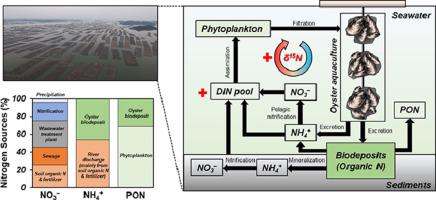Water Research ( IF 11.4 ) Pub Date : 2020-09-25 , DOI: 10.1016/j.watres.2020.116431 Hao Jiang , Wenlu Lan , Tianshen Li , Zhifang Xu , Wenjing Liu , Ke Pan

|
To offset estuarine eutrophication, interest is increasing in restoring oyster reefs and expanding oyster aquaculture. However, ecosystem-scale evidence is lacking on oyster assemblages’ impacts on estuarine pelagic nitrogen (N) cycling. Using a multiple-isotope approach and isotope-mixing model, we examined the sources, transformations, and influence of intensive oyster aquaculture on N pollution in a subtropical estuary. The salinity-dependent NO3– and NH4+ concentrations and their correlations with isotopic signals (δ15N-NO3–, δ18O-NO3–, δ15N-NH4+) indicated the nutrient spatial distribution in low-salinity areas was largely regulated by mixing between freshwater and seawater. However, the intensive oyster aquaculture greatly increased nitrification in the estuary. In high-salinity areas where oyster assemblages were absent, the assimilation of NO3– by phytoplankton became dominant and sharply increased the δ15N-NO3– and δ18O-NO3–. Soil organic nitrogen and fertilizer, domestic sewage, and wastewater treatment plants were the major NO3– sources in the estuary, while internal nitrification contributed 20.6% to the NO3– pool. Oyster biodeposits comprised up to one-third of the particulate organic matter in the water column, and as much as 47.3% of the NH4+ pool could be from the oysters. Our study shows that oysters significantly contribute to the pelagic nutrient pools and N transformations, adding an important dimension to our understanding of oyster assemblages’ impacts on estuarine N cycling.
中文翻译:

同位素组成揭示了牡蛎养殖对亚热带河口上层氮循环的影响。
为了抵消河口富营养化,人们对恢复牡蛎礁和扩大牡蛎养殖的兴趣日益增加。然而,缺乏生态系统规模的证据表明牡蛎组合对河口上层氮(N)循环的影响。我们使用多同位素方法和同位素混合模型,研究了亚热带河口集约化牡蛎养殖的来源,转化及其对氮污染的影响。盐度依赖性NO 3 -和NH 4 +的浓度和它们的同位素的信号的相关性(δ 15 N-NO 3 -,δ 18 O型NO 3 -,δ 15 N-NH 4 +)表明,低盐度地区的养分空间分布很大程度上受淡水和海水之间的混合作用的调节。但是,牡蛎集约化养殖大大增加了河口的硝化作用。在牡蛎组合缺席高盐度的区域,NO的同化3 -由浮游植物成为主导和急剧增加的δ 15 N-NO 3 -和δ 18 O型NO 3 - 。土壤有机氮和肥料,生活污水和废水处理厂是主要的NO 3 -在河口来源,而内部硝化贡献20.6%至NO 3 -池。牡蛎的生物沉积物最多占水柱中颗粒有机物的三分之一,并且多达47.3%的NH 4 +库可能来自牡蛎。我们的研究表明,牡蛎显着促进了中上层营养库和氮的转化,为我们理解牡蛎组合对河口氮循环的影响增加了重要意义。











































 京公网安备 11010802027423号
京公网安备 11010802027423号